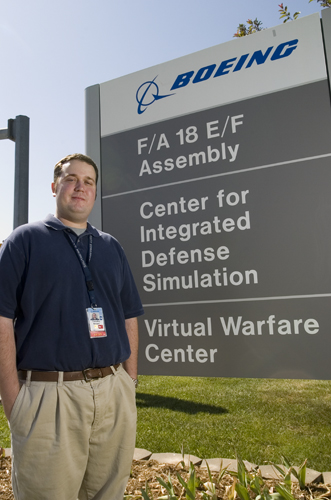Chicago-based Boeing has a proven track record in aircraft carrier construction dating back to 1921. The company now claims to have assembled the world's most experienced and successful engineering team working on carrier suitability and autonomous operations. This team includes SIUE alumnus Timothy Brown (B.A. '01, Applied Mathematics; M.S. '03, Theoretical Mathematics), whose areas of specialization include optimal control, numerical analysis and linear algebra.

|
Boeing is the world's leading aerospace company and the largest combined manufacturer of commercial jetliners and military aircraft. With additional capabilities in rotorcraft, electronic and defense systems, missiles, rocket engines, satellites, launch vehicles and advanced information and communication systems, the company's reach extends to customers in 145 countries with more than 150,000 employees in 70 countries.
Brown, who joined Boeing in 2003, works in St. Louis in the company's Integrated Defense Systems (IDS) business unit. This unit uses the capabilities of aircraft aviation and sophisticated communication networks to provide air-, land-, sea- and space-based platforms for global military, government and commercial customers. In his position as Engineer/Scientist 2 in the Operations Analysis department, Brown currently works on the Navy-Unmanned Combat Air System (N-UCAS), an aircraft carrier based unmanned, autonomous combat air system that is designed for long endurance, operational missions to provide continuous intelligence, surveillance and reconnaissance (ISR) of the battle space and deliver precision weapons on target in a high threat environment for the U.S. Navy.
"My mathematics skills allow me to simplify complex problems, both large and small, into manageable pieces," Brown noted.
Brown said he originally became interested in mathematics in high school, because he thought it provided a single way to solve a problem. "At that time, I thought that having a 'single way to solve a problem' meant that I could learn anything once I understood the mechanics of the solution, and this made mathematics seem easy to me," he said. "I soon learned, however, that not only are there numerous ways to solve any given problem, but that most college-level mathematics is not mechanical." By the time Brown realized this, however, he was already a sophomore in college and had begun to appreciate the challenges his math courses posed.
But Brown's job doesn't end with merely solving a problem. "The most important part of the job is not solving the problems but presenting your results in a clear and concise way to your audience," he said. His biggest challenge generally consists of people with knowledge ranging from expert to novice, and he must be able to explain his solutions to everyone without alienating anyone. "No matter how great your idea or solution is, it is meaningless unless you can communicate it effectively."
Brown described the most satisfying aspect of his job is working together as part of a team to solve a difficult problem. "Seeing my team's broad range of education, experience and innovation integrated and working toward the same goal is a great feeling."
